Ostrava
| Ostrava | |||
| City | |||
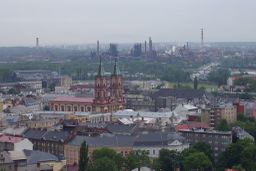 |
|||
|
|||
| Country | Czech Republic | ||
|---|---|---|---|
| Region | Moravian-Silesian | ||
| Little District | Ostrava | ||
| Parts |
23
|
||
| Center | Masarykovo náměstí | ||
| - elevation | 260 m (853 ft) | ||
| - coordinates | |||
| Area | 214 km² (83 sq mi) | ||
| - metro | 3,896 km² (1,504 sq mi) | ||
| Population | 336,557 (March 31, 2009) | ||
| - metro | 1,164,328 [1] | ||
| Density | 1,589.2 / km² (4,116 / sq mi) | ||
| Founded | 1267 | ||
| Mayor | Petr Kajnar (ČSSD) | ||
| Postal code | 702 00 | ||
  Location in the Czech Republic
|
|||
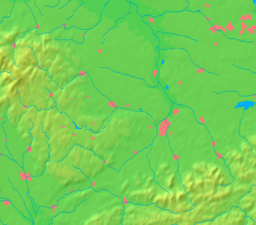  Location in the Moravian-Silesian Region
|
|||
| Website: www.ostrava.cz | |||
Ostrava (Czech pronunciation: [ˈostrava] (![]() listen), German: Ostrau, Polish: Ostrawa) is the third largest city in the Czech Republic and the second largest urban agglomeration after Prague. It is also the administrative center of the Moravian-Silesian Region and of the Municipality with Extended Competence. Ostrava is candidate for the title of European Capital of Culture 2015. Ostrava is located at the confluence of the Ostravice, Oder, Lučina and Opava rivers. Its history and growth have been largely affected by exploitation and further use of the high quality black coal deposits discovered in the locality, giving the town a look of an industrial city and a nickname of the “steel heart of the republic” (Czech: ocelové srdce republiky) during the communist era of Czechoslovakia. Many of the heavy industry companies are being closed down or transformed.
listen), German: Ostrau, Polish: Ostrawa) is the third largest city in the Czech Republic and the second largest urban agglomeration after Prague. It is also the administrative center of the Moravian-Silesian Region and of the Municipality with Extended Competence. Ostrava is candidate for the title of European Capital of Culture 2015. Ostrava is located at the confluence of the Ostravice, Oder, Lučina and Opava rivers. Its history and growth have been largely affected by exploitation and further use of the high quality black coal deposits discovered in the locality, giving the town a look of an industrial city and a nickname of the “steel heart of the republic” (Czech: ocelové srdce republiky) during the communist era of Czechoslovakia. Many of the heavy industry companies are being closed down or transformed.
Contents |
History
Ostrava was an important crossroads of prehistoric trading routes, namely the Amber Road. Archaeological finds have proved that the area around Ostrava has been permanently inhabited for 25,000 years. The town itself was founded in 1267. Until the late 18th century, Ostrava was a small provincial town with a population around one thousand inhabitants engaged in handicraft.
In 1763, large deposits of black coal were discovered, leading to an industrial boom and a flood of new immigrants in the following centuries. During the 19th century, several mine towers were raised in and around the city and the first steel works were established. Industrial growth was made possible by the completion of Kaiser-Ferdinands-Nordbahn from Vienna in 1847. The 20th century saw further industrial expansion of the city accompanied by an increase in population and the quality of civic services and culture. However, during World War II, Ostrava - as an important source of steel for the arms industry - suffered several massive bombing campaigns that caused extensive damage to the city.
Since the Velvet revolution in 1989 the city has been going through major changes. A thorough restructuring of industry is taking place - coal mining in the area of the city was stopped in 1994 and a large part of the Vítkovice ironworks near the city center was closed down in 1998. Both actions improved the environment dramatically, although the Arcelor Mittal plant (ex-Nová Huť) continues to heavily pollute the Radvanice district and the surrounding area, resulting in one of the highest concentrations of PM10 dust in Europe.[2]
Mayors
| Period | Name |
|---|---|
| 1861–1864 | Hermann Zwierzina |
| 1864–1873 | Alois Anderka |
| 1873–1880 | Konstantin Grünwald |
| 1880–1888 | Anton Lux |
| 1888–1901 | Adalbert Johanny |
| 1901–1918 | Gustav Fiedler |
| 1918 | Johann Ulrich (until 17 December 1918) |
| 1918–1935 | Jan Prokeš |
| 1935–1939 | Josef Chalupník |
| 1939–1940 | Josef Hinner |
| 1940–1945 | SS Sturmbannführer Emil Beier |
| 1945 | Josef Lampa (interim, for three weeks) |
| 1945–1960 | Josef Kotas |
| 1960–1964 | Jan Buchvaldek |
| 1964–1968 | Josef Kempný |
| 1968–1971 | Zdeněk Kupka |
| 1971–1986 | Eduard Foltýn |
| 1986–1989 | Bedřich Lipina |
| 1989–1990 | Lubomír Vejr |
| 1990–1993 | Jiří Smejkal |
| 1993–2001 | Evžen Tošenovský |
| 2001–2002 | Čestmír Vlček |
| 2002–2006 | Aleš Zedník |
| 2006– | Petr Kajnar |
Geography and climate
| Ostrava | ||||||||||||||||||||||||||||||||||||||||||||||||||||||||||||
|---|---|---|---|---|---|---|---|---|---|---|---|---|---|---|---|---|---|---|---|---|---|---|---|---|---|---|---|---|---|---|---|---|---|---|---|---|---|---|---|---|---|---|---|---|---|---|---|---|---|---|---|---|---|---|---|---|---|---|---|---|
| Climate chart () | ||||||||||||||||||||||||||||||||||||||||||||||||||||||||||||
|
||||||||||||||||||||||||||||||||||||||||||||||||||||||||||||
|
||||||||||||||||||||||||||||||||||||||||||||||||||||||||||||
Ostrava is located in the north-eastern area of the Czech Republic, very close to the Polish (15 km) and Slovak (55 km) borders. It spreads over the northern part of the natural north-south valley called the Moravian Gate (Moravská brána) with an average elevation of approximately 210 m (688.98 ft) above sea level.
The local climate is continental temperate, with hot, humid summers and mild, dry winters. The yearly average temperature is 10.2 °C (50 °F) (January low:−1.2 °C (29.8 °F), July high: 25 °C (77 °F)), the yearly rainfall is around 526 mm (20.71 in).
People and demographics
As of March 2009, the official estimated population of Ostrava was 336,557 inhabitants[4], living in a total of 23 districts formed by the unification of 34 original small towns and villages. Ostrava covers an area of 212 km². The population density is 1589 people per km².
Historically, among the most influential ethnic groups besides Czechs in Ostrava were the Poles, Germans and the Jews. However, during and after the World War II years the situation changed completely, as most Ostravian Jews were killed or transported to concentration camps (on October 17, 1939 the first transport of Jews to a lager under the Nisko Plan, and the Nazi administrative innovation known as the General Government was held in Ostrava - the first of its kind in Europe). After World War II, Germans were expelled from Ostrava according to the Potsdam Agreement. Thus, the population of the city, has become a mixture of Silesians, Moravians, Czechs, Slovaks and Poles. The mayor of Ostrava Josef Hinner opposed the deportation with the magistrate and German forces and started to organize the resistance to smuggle Jewish citizens from the city and surrounding areas. Due to his opposition, mayor Hinner was deported and placed in a concentration camp, barely surviving World War II.
Due to the recent and ongoing massive restructuring of the heavy industry in the area, the unemployment rate is 10.76 % (as of March 2009)[5].
Steel industry and underground coal mines

Some of the largest industrial companies lie in the city of Ostrava. The Vitkovice steel works, located in the suburb of the same name near the city center, concentrates on metallurgy and machine engineering. It was established in 1828 and now it is undergoing a major transformation. The oldest part of the company, called "Dolní oblast" (the "Lower area"), was closed down and there is an ongoing debate whether this area should be preserved as an industrial open-air museum or torn down. Another key metallurgical enterprise in Ostrava, Nová huť (the "New Steel Works"), established in 1951, belongs to the international company ArcelorMittal.
All underground coal mines were closed down shortly after the Velvet revolution in 1989, due to unfavourable geological and political conditions which caused mining to become uneconomical in the post-communist system, and also because of ex-mayor Evžen Tošenovský's drive to modernize the city's industries. The last minecart with coal was retrieved from new Odra Mine (formerly František Mine) on June 30, 1994.[6]
Karolina
Karolina is name of area approximately 30 hectares in size situated 500 m (1,640.42 ft) from the city's historic square. The Karolina area was originally used for heavy industry. After demolition of the old coking plant and clearing the entire area, the Karolina site can now be used to extend the Ostrava city centre.
In late June 2006 the Dutch firm Multi Development won the contract to develop the grounds of the former Karolina site. Multi Development plans to invest 13 billion CZK (EUR 450 million).
Many new apartment buildings, offices and shops are planned for this new city district. There will also be a new church, a high-rise building, a large park by the Ostravice River and a university campus.
Culture
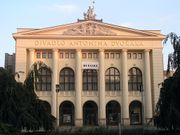
There are four theatres in Ostrava: Moravian-Silesian National Theatre (Národní divadlo moravskoslezské). It has two buildings: Divadlo Antonína Dvořáka (named after Antonín Dvořák) and Divadlo Jiřího Myrona. Further there are Petr Bezruč Theatre (named after Petr Bezruč), Komorní scéna Aréna (Chamber theatre Arena) and Divadlo loutek (Puppet theatre).
Ostrava's Janáček Philharmonic Orchestra (formerly called the Czech Radio Orchestra) is one of Europe's better orchestras.
Ostrava also stands for the European Capital of Culture 2015.
Education
- VŠB – Technical University of Ostrava
- University of Ostrava
- Business School Ostrava plc
Main sights
While Ostrava is usually not in the top ten list of tourist attractions of the Czech Republic, there are a number of interesting places to see and things to do there. To the north of the city center there is the Museum of Mining (Hornické muzeum) presenting a unique collection of the coal mining machinery and equipment, a reconstruction of a mammoth hunters' settlement. Going down the shaft to see the 250m-long underground corridors and an original mining gallery from the 19th century is also part of the exhibition.
Just to the north and running west of the Museum of Mining is a fortification system known as the "Beneš Wall", a line of garrison fortifications similar to the Maginot Line. The hurried construction of the line of defenses was of great concern to the German military, and after German annexation was used by the German military to train for their attacks against comparable fort complexes on the Western front.
Another attraction, which is becoming more and more popular mainly among young people, is Stodolní Street (Stodolní ulice), actually a collection of streets just next to the center, full of bars, pubs and clubs, bringing night-life to the city and thousands of visitors all year long. There are currently around 60 places to have a drink or dance on this street, each with its own style and atmosphere. There are a few bigger events at this area throughout the year, the largest of which is the Colours of Ostrava - a summer music festival hosting many musicians and groups from all over the world.
The new city hall viewing tower provides visitors a panoramic view of the city and surroundings from a height of about 72 meters. During clear weather the Moravian-Silesian Beskids and Jeseníky mountain ranges are visible.
The Silesian Ostrava Castle is one of the city's most historic cultural monuments. The castle was built in the eighties and nineties of the 13th century. In 1534, the gothic castle was rebuilt into a renaissance chateau. It was restored recently after many years of dilapidation caused by coal mining under the castle. Today, the castle is one of the most important tourist attraction of the city. It hosted the Colours of Ostrava music festival in 2007.
You can visit a zoological garden located in Stromovka park in Slezská Ostrava. On May 1, 1960 it was opened to the public.
Sport
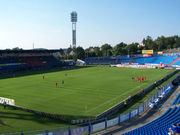
Ostrava has teams in the three major Czech Republic professional sports leagues (football, ice-hockey and basketball). The city's two current League football teams are FC Baník Ostrava and FC Vítkovice. FC Baník Ostrava represent the city in the Czech Republic 1. League (Gambrinus Liga).
In ice-hockey Ostrava has one team HC Vítkovice represent the city in the Czech Extraliga.
The city's National Basketball League (NBL) team is the NH Ostrava.
Ostrava also supports athletics. Ostrava-Vítkovice hosts the Golden Spike athletics meeting, one of the IAAF World Challenge Meetings.
Transport
Public Transport
Public transport infrastructure consists of 17 tram (streetcar), 9 trolleybus, 59 day bus lines. Service is provided mainly by Dopravní Podnik Ostrava a.s. (Ostrava City Transportation Company).
Rail
Ostrava lies on the main rail route connecting Vienna and Warsaw. Ostrava, as a third largest city, has direct train connection with the capital city Prague. Some EuroCity trains go also to Žilina and Košice.
International relations
Twin towns — Sister cities
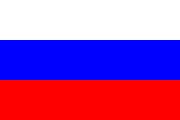 Volgograd, Russia, from 1957
Volgograd, Russia, from 1957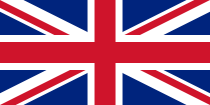 Coventry, United Kingdom, from 1957
Coventry, United Kingdom, from 1957 Katowice, Poland, from 1960
Katowice, Poland, from 1960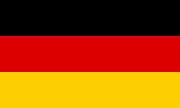 Dresden, Germany, from 1971 [7]
Dresden, Germany, from 1971 [7]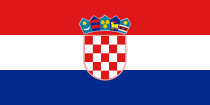 Split, Croatia, from 1976
Split, Croatia, from 1976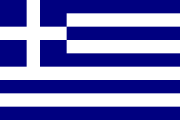 Pireus, Greece, from 1997
Pireus, Greece, from 1997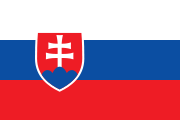 Košice, Slovakia, from 2001[8]
Košice, Slovakia, from 2001[8] Miskolc, Hungary, from 2001
Miskolc, Hungary, from 2001 Pittsburgh, USA, from 2001
Pittsburgh, USA, from 2001 Powiat Wodzisławski, Poland, from 2005
Powiat Wodzisławski, Poland, from 2005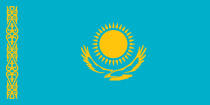 Western, Kazakhstan, from 2008
Western, Kazakhstan, from 2008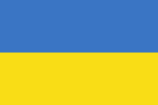 Donetsk, Ukraine, from 2009
Donetsk, Ukraine, from 2009
Ostrava has two triangular partnerships with Coventry: one with Volgograd since 1957 and one with Dresden since 1971.
International links
- Honorary consulate of the Russian Federation [9][10]
People
- See also the related Category:People from Ostrava.
|
|
|
|
Vítkovice
- Alexander Sacher-Masoch (1901 - 1972), writer, acted in Austria[11]
- Ilse Weber (1903 - 1944), female writer, acted in Austria
- Leopold Ludwig (1908 - 1979), Kapellmeister, acted in Germany[12]
Notes
- ↑ Larger urban zone, Eurostat 2003
- ↑ "Ostravsko už ví, proč má špatný vzduch. Špiní jej hutě". 2008. http://aktualne.centrum.cz/domaci/zivot-v-cesku/clanek.phtml?id=519268. Retrieved 2008-07-04.
- ↑ "Monthly Averages for Ostrava, Czech Republic". http://www.weather.com/outlook/travel/businesstraveler/wxclimatology/monthly/graph/EZXX0009?from=search. Retrieved 2008-02-28.
- ↑ "Počet obyvatel v Moravskoslezském kraji a jeho okresech v 1. čtvrtletí 2009 (Czech language)". ČSÚ - Statistický bulletin – Moravskoslezský kraj za 1. čtvrtletí 2009. March 31, 2009. http://www.czso.cz/xt/edicniplan.nsf/t/E80037B24C/$File/80130209q1d01.pdf. Retrieved 2009-09-31.
- ↑ "Nezaměstnanost podle krajů a okresů v ČR k 31. 3. 2009 (Czech language)". ČSÚ - Statistický bulletin - Nezaměstnanost. March 31, 2009. http://www.czso.cz/xt/edicniplan.nsf/t/E800388B88/$File/80130209q1g03.pdf. Retrieved 2009-09-31.
- ↑ "Historie hornictví - Důl František, Ostrava - Přívoz (Czech language)". Hornictvi.info. 11 August 2009. http://www.hornictvi.info/histhor/lokality/okr/08.htm. Retrieved 2009-09-30.
- ↑ "Dresden - Partner Cities". © 2008 Landeshauptstadt Dresden. http://www.dresden.de/en/02/11/c_03.php. Retrieved 2008-12-29.
- ↑ "Partnership towns of the City of Košice" (in Slovak). © 2007-2009 City of Košice Magistrát mesta Košice, Tr. SNP 48/A, 040 11 Košice. http://www.kosice.sk/clanok.asp?file=gov_s_c-00.html. Retrieved 2009-07-12.
- ↑ Honorární konzulát Ruské federace v Ostravě
- ↑ Honorary consulate of the Russian Federation in Ostrava
- ↑ (de)
- ↑ (de)
External links
- Ostrava travel guide from Wikitravel
- (Czech) Official web
- (English) DPO - Public Transport in Ostrava
- (English) City information center
- (English) Zoo Ostrava official website
- (English) Ostrava is candidate for the title of European Capital of Culture 2015
- MÄHRISCH-OSTRAU 1923
|
|||||
|
||||||||||||||
|
|||||||


